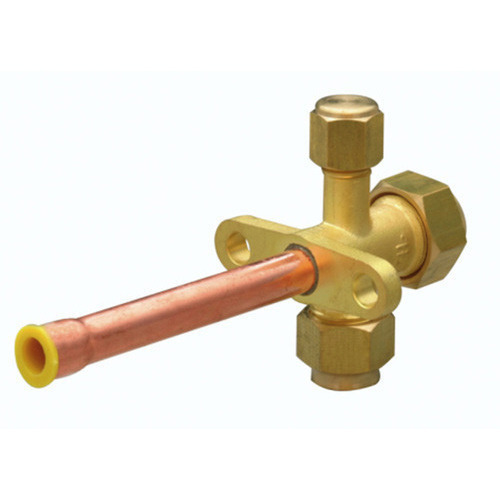
Heating, ventilation, and air conditioning (HVAC) systems are integral to maintaining indoor comfort. These systems comprise intricate components, and among them, service valves play a crucial role in facilitating maintenance and servicing by HVAC technicians. In this article, we will delve into the concept of HVAC service valves, their significance, materials of construction, working principles, and the various types available in the market.
The Significance of Service Valves
In the world of HVAC systems, service valves, also known as AC valves, serve as essential connectors in the refrigeration pipeline. These pipelines, typically made of pure copper, transport refrigerant between different components of the HVAC system. Service valves enable HVAC technicians to conduct a myriad of tests and services without disrupting the system’s operation.
Why Are Air Conditioner Service Valves Usually Made of Brass?
- Simple Manufacturing Process: Brass, a copper-zinc alloy, is favored for service valve construction due to its relatively simple manufacturing process. The lower hardness of brass makes cutting, forging, machining, and assembly easier compared to materials like stainless steel or bronze.
- Good Mechanical Properties: Brass exhibits favorable mechanical properties, making it an ideal choice for service valves. Its sealing effectiveness, combined with a lower cost than materials like stainless steel, contributes to its widespread use in HVAC applications.
- Versatility: Brass valves are versatile, suitable for medium and low-pressure applications as well as high-pressure scenarios. Their structure is robust, ensuring reliable long-term operation with efficient sealing.
- Wear Resistance: The friction between the valve disc and the valve body sealing surface is minimal in brass valves. This results in excellent wear resistance, low depreciation rates, and an extended service life.
The adoption of brass service valves not only enhances energy efficiency and the safety of production equipment but also reduces maintenance costs and provides a cleaner and safer working environment.
How Service Valves Work
Service valves enable HVAC technicians to conduct various tests and services crucial for the proper functioning of HVAC systems. By connecting pressure-reading devices to service valves, technicians can assess the pressure levels within the AC system. Additionally, service valves play a pivotal role in charging and releasing refrigerants.
Charging the System
Charging is the process of adding refrigerant to an AC system. Low refrigerant levels can result in a failure to cool a space adequately. HVAC technicians connect a device to the service valve to restore the refrigerant levels, ensuring the system’s ability to cool effectively.
Releasing Refrigerant
Service valves also allow technicians to release refrigerant when necessary. Overcharging, or the presence of excess refrigerant, can lead to compressor damage, reduced cooling performance, and increased wear and tear on the AC system. Service valves provide a controlled means to release refrigerant, preventing potential issues.
Understanding Service Valves
What Is a Service Valve?
The service valve, also referred to as a service port, is a critical component in HVAC systems used by technicians during maintenance. Typically located among the refrigeration lines near the compressor, the service valve serves as a bridge between the HVAC technician’s equipment and the air conditioning system.
Furthermore, service valves enable technicians to isolate specific components without disrupting the entire system. This functionality proves invaluable during refrigerant-related services, allowing technicians to work on one part of the system without affecting its overall operation.
Service Valve Usage
Service valves, similar to the valves on a car tire, are airtight when not connected to a device. HVAC technicians leverage these valves for various services:
- Refrigerant Removal: In the case of overcharging, technicians can use service valves to safely remove excess refrigerant.
- Refrigerant Addition: Technicians can force new replacement refrigerants into the system through service valves.
- Leak Correction: If there’s a refrigerant leak, additional refrigerant can be added to compensate for the loss.
- Pressure Measurement: Technicians measure the refrigerant gas pressure within the system using service valves.
Types of Service Valves
Service valves come in various types, each designed for specific applications and functionalities. Three common types include two-position service valves, three-position service valves (king valves), and ball-type valves.
Two-Position Service Valves
Widely used in air conditioning systems, these valves allow the isolation of the compressor compartment from the system’s evaporator. Many also include a chamber for the metering device, enabling the refrigerant to bypass through and around the metering device.
Three-Position Service Valves (King Valves)
Also known as king valves, these are commonly used in HVAC systems to connect or lock off the receiver tank from the liquid line. They also facilitate the connection of the compressor compartment to the evaporator, allowing isolation when needed.
Ball-Type Valves
These valves, resembling household gas or water valves, display the directional flow of refrigerant. While simpler in design, they lack the control over the flow at the port seen in other valve types. However, they have fewer chances of causing leaks.
Conclusion
In conclusion, HVAC service valves are indispensable components that enable HVAC technicians to maintain and service air conditioning and refrigeration systems effectively. Their construction from materials like brass ensures durability, ease of manufacturing, and optimal performance. Understanding the different types of service valves and their functionalities empowers both technicians and homeowners to appreciate the intricate workings of HVAC systems and the importance of regular maintenance. Service valves not only play a role in enhancing system efficiency but also contribute to the longevity and reliability of HVAC installations.